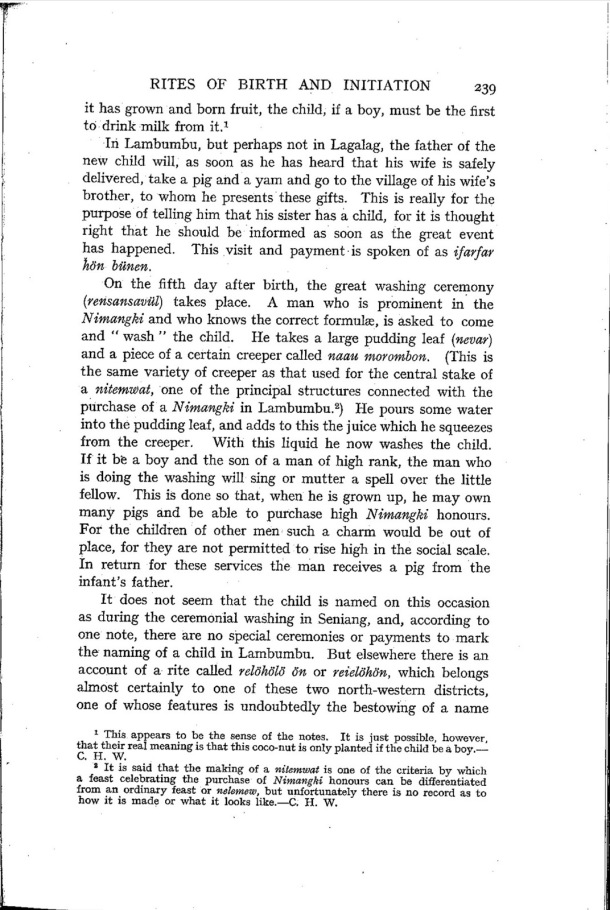|
|  [Note: this transcription was produced by an automatic OCR engine]
k
Tâ€ù l
RITES OF BIRTH AND INITIATION 239
it has grown and horn fruit, the child, if a boy, must be the ï¬Årst
to drink milk from it.1
In Lambumbu, but perhaps not in Lagalag, the father of the
new child will, as soon as he has heard that his wife is safely
delivered, take a pig and a yam and go to the village of his wiie’s
brother, to whom he presents these gifts. This is really for the
purpose of telling him that his sister has a child, for it is thought
right that he should be informed as soon as the great event
has happened. This visit and payment-is spoken of as ifarfar
hdn bimen.
On the ï¬Åfth day after birth, the great washing ceremony
(rensansmnil) takes place. A man who is prominent in the
Nimangki and who knows the correct formulae, is asked to come
and " wash " the child. He takes a large pudding leaj (nevar)
and a piece of a certain creeper called naau morombon. (This is
the same variety of creeper as that used for the central stake of
a nitemwai, one of the principal structures connected with the
purchase of a Nimamgki in Lambumbuï¬Å‘) He pours some water
into the pudding leaf, and adds to this the juioe which he squeezes
from the creeper. With this liquid he now washes the child.
If it be a hoy and the son of a man of high rank, the man who
is doing the washing will sing or mutter a spell over the little
fellow. This is done so that, when he is grown up, he may own
many pigs and he able to purchase high Nimnmgki honours.
For the children of other men such a charm would be out of
place, for they are not permitted to rise high in the social scale.
In return for these services the man receives a pig from the
infar1t’s father.
It does not seem that the child is named on this occasion
as during the ceremonial washing in Seniang, and, according to
one note, there are no special ceremonies or payments to mark
the naming of a child in Lambumbu. But elsewhere there is an
account of a rite called relohï¬Ålb‘ ï¬Ån or reieléhdn, which belongs
almost certainly to one of these two north-western districts,
one of whose features is undoubtedly the bestowing of a name
1 This appears to be the sense of the notes. It is just possible, however,
téiat the; real meaning is that this COCO-nut is only planted if the child be a boy.—
' It is said that the making of a nilamwat is one oi the criteria by which
L feast celebrating the purchase of Nimangki honours can be diï¬Åerentiated
from an ordinary feast or Mlsmew, but uniortunately there is no record as to
how it is made or whet it looks like.—C. H. W.
|
| |